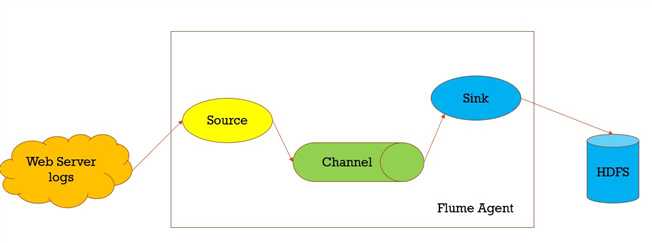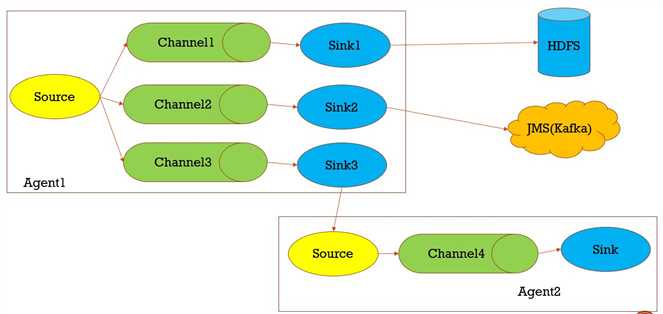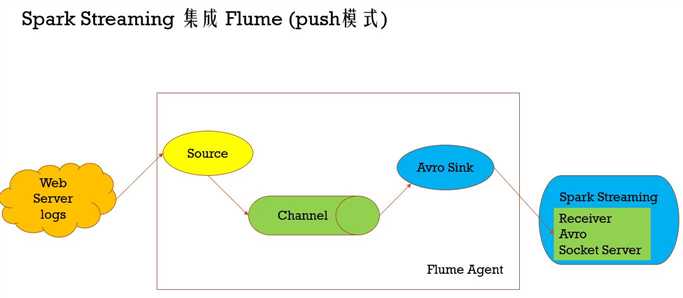## 定义 sources、channels 以及 sinks agent1.sources = netcatSrc agent1.channels = me moryChannel agent1.sinks = loggerSink ## netcatSrc 的配置 agent1.sources.netcatSrc.type = netcat agent1.sources.netcatSrc.bind = localhost agent1.sources.netcatSrc.port = 44445 ## loggerSink 的配置 agent1.sinks.loggerSink.type = logger ## memoryChannel 的配置 agent1.channels.memoryChannel.type = memory agent1.channels.memoryChannel.capacity = 100 ## 通过 memoryChannel 连接 netcatSrc 和 loggerSink agent1.sources.netcatSrc.channels = memoryChannel agent1.sinks.loggerSink.channel = memoryChannel
## 定义 sources、channels 以及 sinks agent1.sources = netcatSrc agent1.channels = memoryChannel agent1.sinks = hdfsSink ## netcatSrc 的配置 agent1.sources.netcatSrc.type = netcat agent1.sources.netcatSrc.bind = localhost agent1.sources.netcatSrc.port = 44445 ## hdfsSink 的配置 agent1.sinks.hdfsSink.type = hdfs agent1.sinks.hdfsSink.hdfs.path = hdfs://master:9999/user/hadoop-twq/spark-course/steaming/flume/%y-%m-%d agent1.sinks.hdfsSink.hdfs.batchSize = 5 agent1.sinks.hdfsSink.hdfs.useLocalTimeStamp = true ## memoryChannel 的配置 agent1.channels.memoryChannel.type = memory agent1.channels.memoryChannel.capacity = 100 ## 通过 memoryChannel 连接 netcatSrc 和 hdfsSink agent1.sources.netcatSrc.channels = memoryChannel agent1.sinks.hdfsSink.channel = memoryChannel
## 定义 sources、channels 以及 sinks agent1.sources = logSrc agent1.channels = fileChannel agent1.sinks = hdfsSink ## logSrc 的配置 agent1.sources.logSrc.type = exec agent1.sources.logSrc.command = tail -F /home/hadoop-twq/spark-course/steaming/flume-course/demo3/logs/webserver.log ## hdfsSink 的配置 agent1.sinks.hdfsSink.type = hdfs agent1.sinks.hdfsSink.hdfs.path = hdfs://master:9999/user/hadoop-twq/spark-course/steaming/flume/%y-%m-%d agent1.sinks.hdfsSink.hdfs.batchSize = 5 agent1.sinks.hdfsSink.hdfs.useLocalTimeStamp = true ## fileChannel 的配置 agent1.channels.fileChannel.type = file agent1.channels.fileChannel.checkpointDir = /home/hadoop-twq/spark-course/steaming/flume-course/demo2-2/checkpoint agent1.channels.fileChannel.dataDirs = /home/hadoop-twq/spark-course/steaming/flume-course/demo2-2/data ## 通过 fileChannel 连接 logSrc 和 hdfsSink agent1.sources.logSrc.channels = fileChannel agent1.sinks.hdfsSink.channel = fileChannel

数据收集,从一个数据源经过channels,Sink到存储结构上,以event的方式发送


import org.apache.spark.SparkConf
import org.apache.spark.storage.StorageLevel
import org.apache.spark.streaming._
import org.apache.spark.streaming.dstream.DStream
import org.apache.spark.streaming.flume._
import org.apache.spark.util.IntParam
/**
* Produces a count of events received from Flume.
*
* This should be used in conjunction with an AvroSink in Flume. It will start
* an Avro server on at the request host:port address and listen for requests.
* Your Flume AvroSink should be pointed to this address.
*
* Flume-style Push-based Approach(Spark Streaming作为一个agent存在)
*
* 1、在slave1(必须要有spark的worker进程在)上启动一个flume agent
* bin/flume-ng agent -n agent1 -c conf -f conf/flume-conf.properties
*
* 2、启动Spark Streaming应用
spark-submit --class com.twq.streaming.flume.FlumeEventCountPushBased --master spark://master:7077 --deploy-mode client --driver-memory 512m --executor-memory 512m --total-executor-cores 4 --executor-cores 2 /home/hadoop-twq/spark-course/streaming/spark-streaming-datasource-1.0-SNAPSHOT-jar-with-dependencies.jar 172.26.232.97 44446
3、在slave1上 telnet slave1 44445 发送消息
*/
object FlumeEventCountPushBased {
def main(args: Array[String]) {
if (args.length < 2) {
System.err.println(
"Usage: FlumeEventCount <host> <port>")
System.exit(1)
}
val Array(host, port) = args
val batchInterval = Milliseconds(2000)
// Create the context and set the batch size
val sparkConf = new SparkConf().setAppName("FlumeEventCount")
val ssc = new StreamingContext(sparkConf, batchInterval)
// Create a flume stream
val stream: DStream[SparkFlumeEvent] = FlumeUtils.createStream(ssc, host, port.toInt, StorageLevel.MEMORY_ONLY_SER_2)
// Print out the count of events received from this server in each batch
stream.count().map(cnt => "Received " + cnt + " flume events." ).print()
ssc.start()
ssc.awaitTermination()
}
}
import org.apache.spark.SparkConf
import org.apache.spark.streaming._
import org.apache.spark.streaming.flume._
import org.apache.spark.util.IntParam
/**
* Produces a count of events received from Flume.
*
* This should be used in conjunction with the Spark Sink running in a Flume agent. See
* the Spark Streaming programming guide for more details.
*
* Pull-based Approach using a Custom Sink(Spark Streaming作为一个Sink存在)
*
* 1、将jar包scala-library_2.11.8.jar(这里一定要注意flume的classpath下是否还有其他版本的scala,要是有的话,则删掉,用这个,一般会有,因为flume依赖kafka,kafka依赖scala)、
* commons-lang3-3.5.jar、spark-streaming-flume-sink_2.11-2.2.0.jar
* 放置在master上的/home/hadoop-twq/spark-course/streaming/spark-streaming-flume/apache-flume-1.8.0-bin/lib下
*
* 2、配置/home/hadoop-twq/spark-course/streaming/spark-streaming-flume/apache-flume-1.8.0-bin/conf/flume-conf.properties
*
* 3、启动flume的agent
* bin/flume-ng agent -n agent1 -c conf -f conf/flume-conf.properties
*
* 4、启动Spark Streaming应用
spark-submit --class com.twq.streaming.flume.FlumeEventCountPullBased --master spark://master:7077 --deploy-mode client --driver-memory 512m --executor-memory 512m --total-executor-cores 4 --executor-cores 2 /home/hadoop-twq/spark-course/streaming/spark-streaming-datasource-1.0-SNAPSHOT-jar-with-dependencies.jar master 44446
3、在master上 telnet localhost 44445 发送消息
*/
object FlumeEventCountPullBased {
def main(args: Array[String]) {
if (args.length < 2) {
System.err.println(
"Usage: FlumePollingEventCount <host> <port>")
System.exit(1)
}
val Array(host, port) = args
val batchInterval = Milliseconds(2000)
// Create the context and set the batch size
val sparkConf = new SparkConf().setAppName("FlumePollingEventCount")
val ssc = new StreamingContext(sparkConf, batchInterval)
// Create a flume stream that polls the Spark Sink running in a Flume agent
val stream = FlumeUtils.createPollingStream(ssc, host, port.toInt)
// Print out the count of events received from this server in each batch
stream.count().map(cnt => "Received " + cnt + " flume events." ).print()
ssc.start()
ssc.awaitTermination()
}
}
原文:https://www.cnblogs.com/tesla-turing/p/11488650.html